

1. Tagonoura Port (Fuji City) 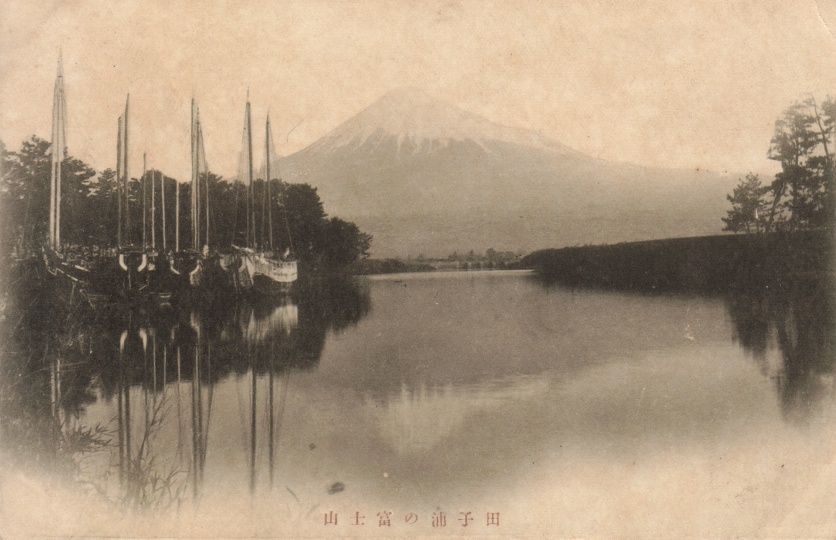 |
It is truly an enchanted land. More than 1,200 years ago, YamabenoAkahito, a court poet, passed through around here and he wrote a famous poem: When I finally pass through the Tago Inlet into open, the pure whiteness laid by the drifting snowfall on lofty peak of Mt. Fuji caught my eyes. By the drift of falling snow. An upside-down Mt. Fuji as reflected on the water surface. The cargo boats on the left-hand side carried fishes from Izu Peninsula, limestone from Sagara, etc. At that time limestone was used for bleaching paper at paper mills because limestone was cheaper than imported caustic soda. You can see a water gate over there. It was built to prevent floods from running up onto Ukishima Marshland near the estuary. The gate was affectionately called Mutsu-Megane. Regretfully, it was removed in 1967 by the construction of the industrial port. Now Tagonoura Port is an international trade port, and it is famous for the very beautiful evening and night views of the coastal industrial zone with Mt. Fuji. |
2. Kawai Bridge (Fuji City) 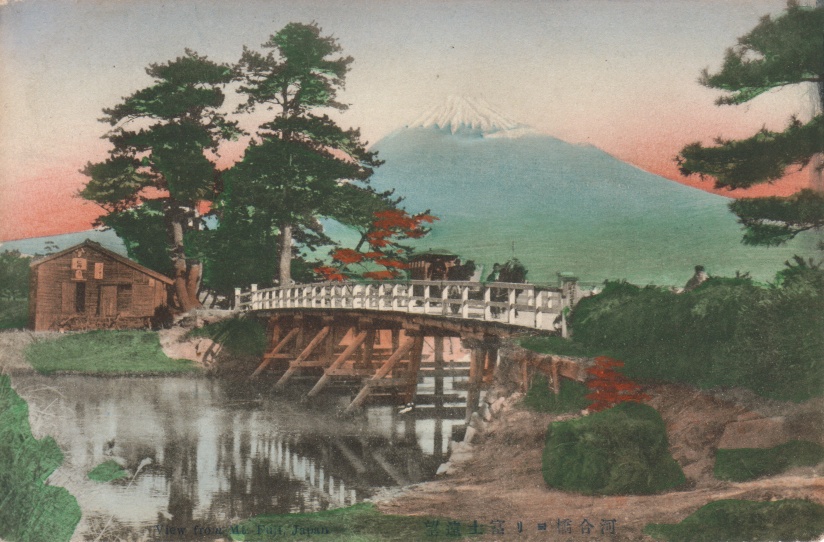 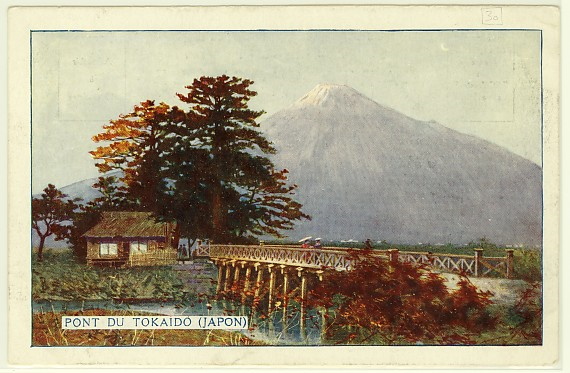 |
Kawai Bridge is situated in the east of Tagonoura Port. On the bridge you can see a horse tramway. The horse tramway was founded in 1890 and the 6th oldest tramway in Japan, as well as the only mean of transportation in Fuji county. The width of the rail line was only 2 feet. Kawai Bridge was also a beautiful spot. We could see the magnificent Mt. Fuji beyond the Kawai Bridge across a clear river and tasteful pine trees. The picture card below was published in France. Mt. Fuji is grand, and the river is clearly depicted. Two young women in red and violet kimono are crossing with lighting from the upper left side. They make an atmosphere brilliant and cheerful. This picture represents the longing for Japanese beautiful scene from foreigners. |
3. Boating on Ukishima Marshland (Numazu City - Fuji City)  Hara in Ukiyoe |
The picture above has the same angle view of Mt. Fuji as depicted in Hara (below), which is one of the ukiyoe works depicting 53 posting stations painted by Hiroshige Utagawa. Ukishima Marshland spread to the south of Mt. Ashitaka. People living beside the Marshland had often suffered heavy damage from flooding until around 1960’s, in which the drainage facility was set because Ukishima Marshland was spreading between Mt. Ashitaka, in the north and sand hills, in the south. They soaked themselves to the chest in order to plant rice. They made living not only by rice farming but also by fishery, so the youngsters were also good at controlling the boat. |
| 4. A Drainage Canal (Fuji City) |
In Edo period farmlands had been troubled by damage from floods and salty breeze again and again in Ukishima, so the farmers even said, “The rice growing can only succeed once in five years.” In 1865, Masuda Heishiro, headman of a village, started to build a drainage canal after 20 years of petition to Edo Bakufu Shogunate. However, unfortunately, right after its completion, a high tide flowed into the drainage canal and destroyed it. Masuda Heishiro died in depression. About 80 years had passed, a new canal was built in the very same place. This proves that his visionary thoughts. You can see Tokaido road across the canal and some boats in Ukishima Marshland in the back. |
5. Foot Waterwheel ‘Yamato’ (Fuji City) |
In Ukishima the farmers were troubled by floods, so foot waterwheel-Yamato was not used for irrigating rice fields but for drainage. A dam can be seen in the drainage. |
| 6. Naka Yoshiwara (Fuji City) 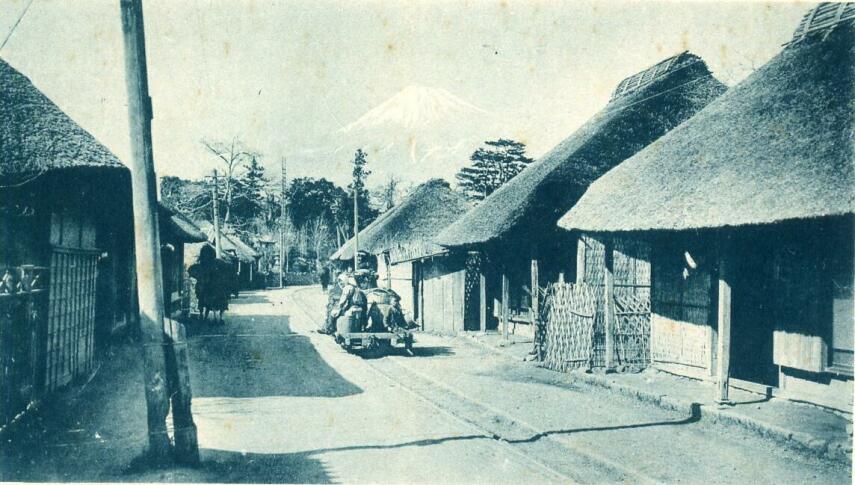 |
From the upper picture, there was a Yoshiwara post station around here from 1639 to 1680. When high tide hit this station in 1680, people ran into the forest of Hidarifuji Shrine as depicted in the center of the middle picture. The forest became the island floating on the sea. More than 700 people were killed by the high tide. In 1755, the villagers built the monument (picture on the right) in the shrine to tell the story of the disaster to posterity. Walking towards the north from here for some 3 minutes, you will arrive at the scenic spot-Hidarifuji. 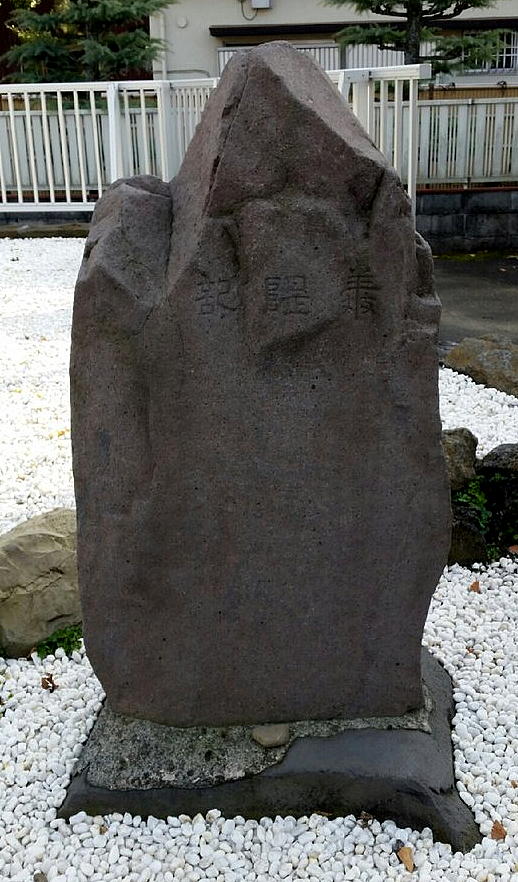 |
| 7. Hidarifuji (Fuji City) 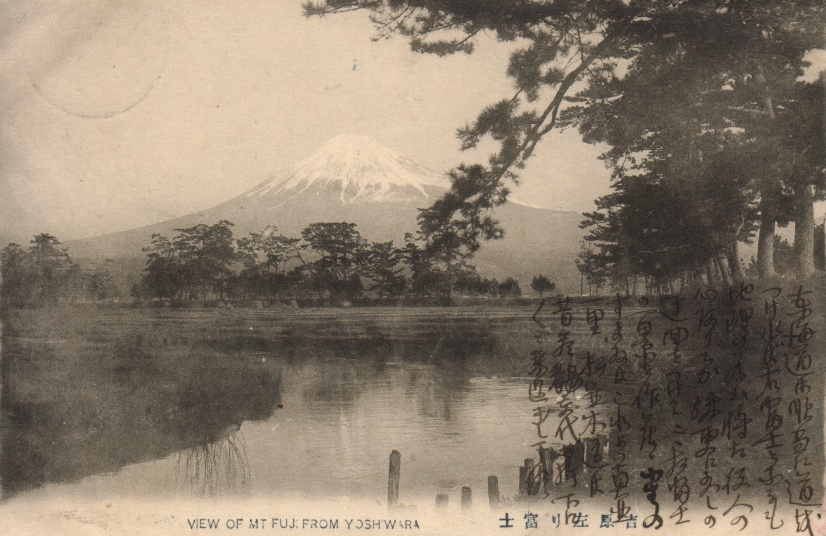 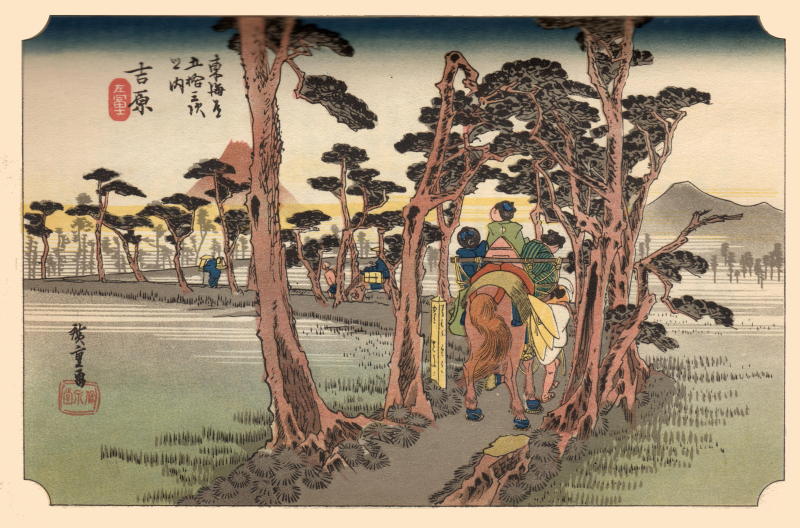 Yoshiwara in Ukiyoe |
Hidarifuji is famous because of Yoshiwara which was illustrated in one of the ukiyoe works painted by Hiroshige Utagawa. In his diary: Hara and Yoshiwara are the best places to enjoy seeing Mt. Fuji’s beautiful shape. At Hidarifuji, when I go down to Edo, Mt. Fuji is to the right. When I go up to Kyoto, it is to the left. The scenery at Hidarifuji has magnificent beauty when I see Mt. Fuji through an avenue of pine trees, which was more than 100 meters. Through the upper picture taken in about 1910, we can see that early in the 20th century the old scenery remained the same in the ukiyoe. Today, Hidarifuji is surrounded by many factories and houses, so unfortunately, we cannot see the tranquil scene as depicted in ukiyoe. But one old pine tree reflecting the ancient glory of Edo period. 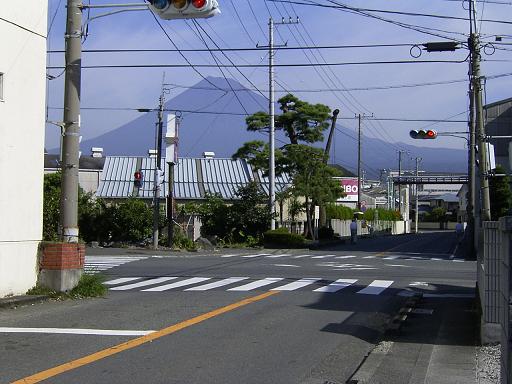 Hidarifuji, today |
| 8. Heikegoe Bridge (Fuji City) 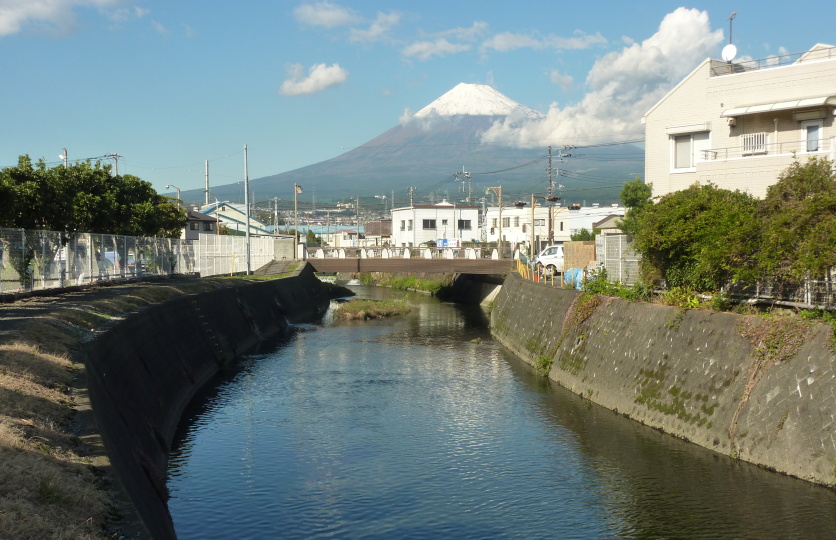 |
Heikegoe bridge was called as Shimbashi in old times, and it spans the Wada river. After crossing the bridge, people arrived at the east gate of Yoshiwara-juku Station of Tokaido road in Edo period. ‘Heikegoe' was named after an oral tradition. That was in 1180, when Genji military stood face to face with Heike military across the Fuji river, Heike army was surprised and scattered by the big sound of waterfowl taking off at the same time. They mistakenly considered the sound as Genji’s attack. Azumakagami, an official history of those days, says a military commander of Heike was killed in ‘Samejima’. Samejima is located nearby in the west of Tagonoura port. Approximately 100 years later of the battle, a nun crossed 15 rivers to around here. This story was written in her diary Izayoi-nikki. Furthermore, from the result of the bowling investigation, it is thought that the Fuji River was divided into many streams, and the main stream of them flowed into Tagonoura port in those days. Heikegoe is near Tagonoura, so it is not strange even if the competition between two forces faced each other in this area. The Wada river was named after Wada Yoshimori, a Gokenin (shogunal retainer ). He built the fence Sakamogi in the river. |
9. Nishiyoko Street (Fuji City) 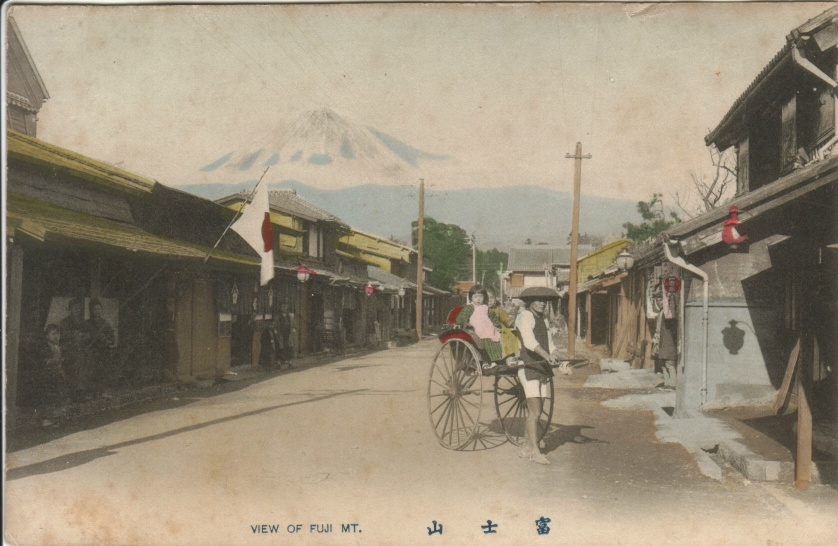 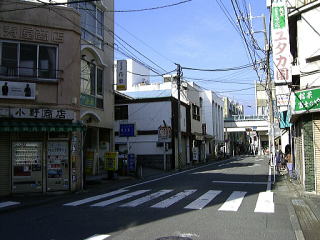 |
Nishiyoko street in the late 19th century (upper picture). This road is Tokaido. There are a girl and a boy on the jinrikisha, a rickshaw. Electric power supply has started in this town since 1908. On the left hand side, Nabeso Japanese-type drapery shop, and a soy sauce shop, etc. can be seen. The shop that can be seen behind the rickshaw man is NAITO hardware shop, which has been carried on ever since. The picture below was taken at the same place several years ago. All shops have changed really, but the zone divisions are the same. In Edo period, each house alongside the Tokaido road was confined to a frontage of 5.4 meters, and if exceeding 5.4m, the amount of taxation increased. The demarcation remains the same as of today. |
| 10. Rural Landscape (Fuji City)  |
From the picture on the left hand side, there are two little girls. Each girl has a baby carried on her back. At that time, taking care of a baby was girls' job. Clean air, clear stream, and quiet rural landscape. Only the murmur of the stream can be heard. In the picture, you can also see a stone bridge that is relatively rare in Japan. A traveler's journal written in Edo period says there were dozens of stone bridges between Yoshiwara Station and Fuji river. Nowadays, the excavated stone bridges (below) are preserved among the shrubbery of the roadside trees close to the Nishikicho crossing, which is approximately 200 meters east from Fuji city hall. 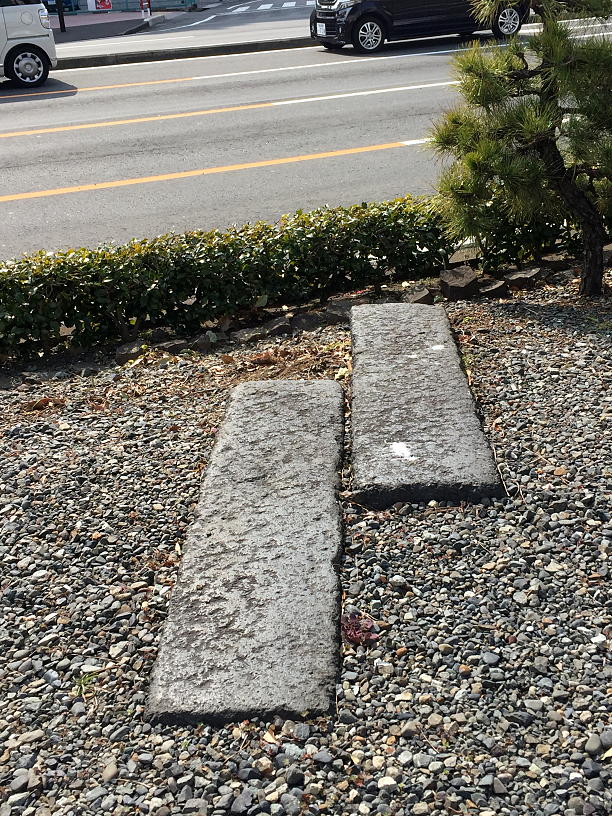 |
| 11. Harvest in Aoshima (Fuji City) |
From the picture, Mt. Iwamoto is on the left, and the roof of Fuchi Rokusho Sengen shrine is in the center. So this picture was taken in Aoshima along the Tokaido road. There is a threshing machine in the center, and the straw has been already bundled up. Men have already finished their works and withdrawn. The woman on the right seems to be selecting better grains of rice from the poor ones. So valuable were the grains of rice handled with the greatest care. |
| 12. Tomiyasu-Bashi Bridge (Fuji City) 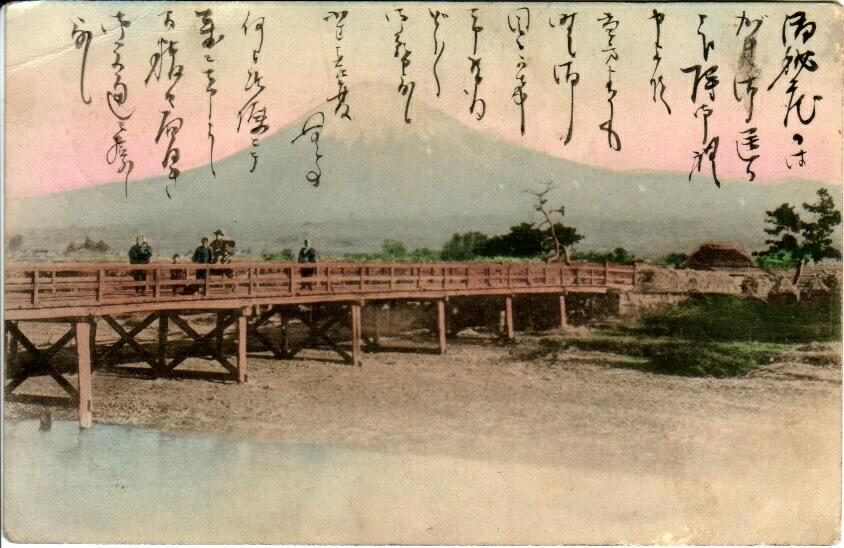 |
Tomiyasu Bridge spans the Urui river. It was once called Sando Bridge in Edo period, and kept up by the express messenger. “Sando” means “three times” in Japanese. The name came from the following fact that the express messenger carried mails three times a month. Nowadays, you can see Fuji City General Hospital beyond the bridge now. |
13. Shipping of geta, wooden clogs (Fuji City)  |
The Lacquered getas were made specially in Shizuoka, and those bases were once made in Takaoka and Fujinomiya. This picture was taken near Sando Bridge (now Tomiyasu Bridge). Then, why did they carry in the opposite direction to Shizuoka? The key to solving the question is the head of the man pulling the cart. His hair style is called chonmage-topknot. In 1871, a government regulation to cut and remove topknots was issued, so this picture was possibly taken in those days. There were no railroad or canal in Fuji area at that time, so getas were possibly carried to the Tagonoura port once and shipped to Shizuoka. |
| 14. Mochi-tsuki (Fuji City) 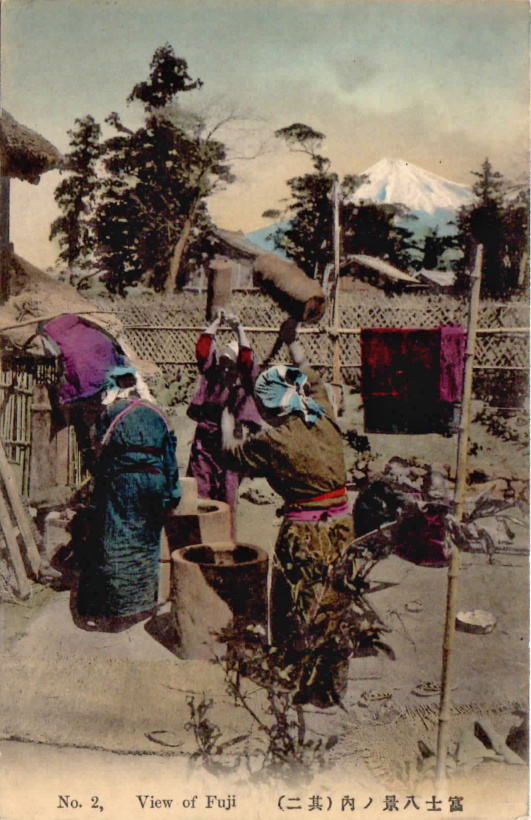 |
Mochi-tsuki is pounding steamed rice into mochi rice cake. This picture seems to have been taken in Kajima according to the angle of the valleys of Mt. Fuji and the direction of the shadows, etc. The women tightened waist cord well and pounded the rice into mochi. Then, where had men gone? Several buildings can be seen beyond the wonderful Shibagaki fence, so this place is a garden of a wealthy farmer. The Mochi-tsuki women might be tenant farmers. |
| 15. A Farmer and a Horse Walking on the Dike (Fuji City) 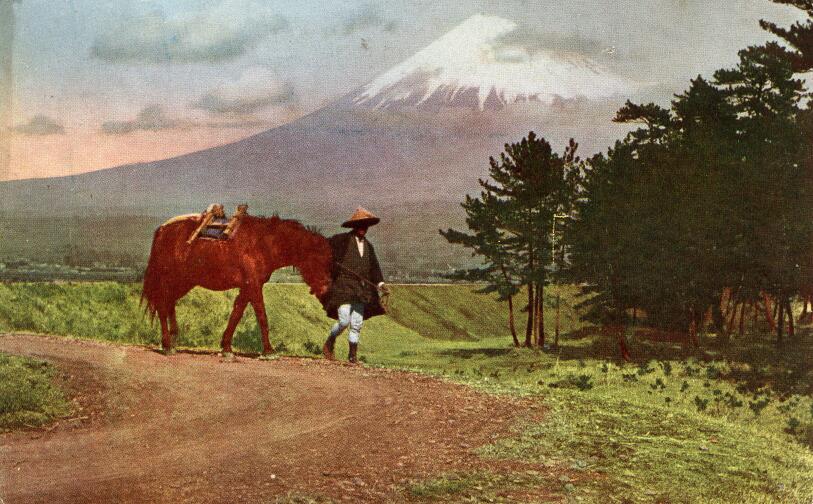 |
Fujikawa caused floods many times. The floods damaged the fields and tormented people. Then Mr. Furugoori of Nakazato Village completed the Karigane-zutsumi dike after over 50 years of flood prevention works. It was a construction with great difficulty, so the legend of Hitobashira (the practice of burying people alive under pillars of structures to ensure protection) has been handed down. Then, the Furugoori family was very unique. One progeny succeeded in the river improvement in Fukui. However, he took the responsibility for over estimated budgets and committed harakiri. Another progeny was awarded an important position of Edo government by tributing shogun Abekawa-mochi rice cakes. |
| 16. Fujikawa Bridge (Fuji City) 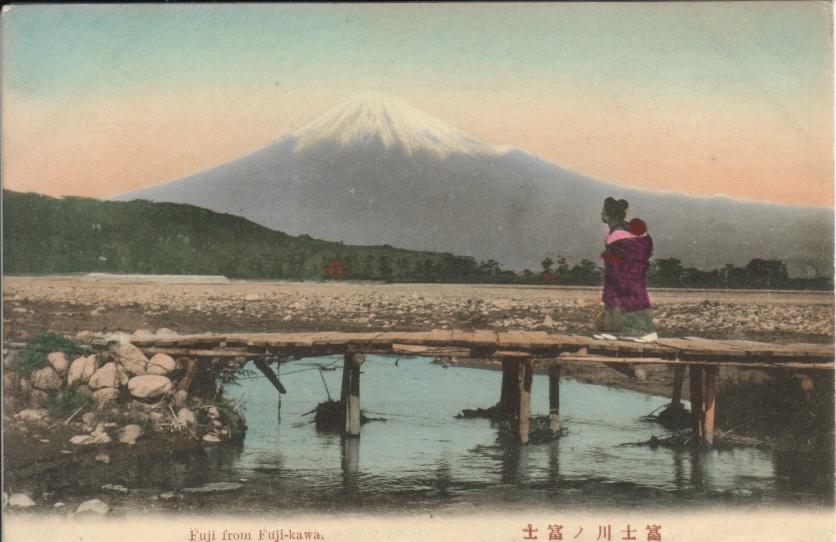 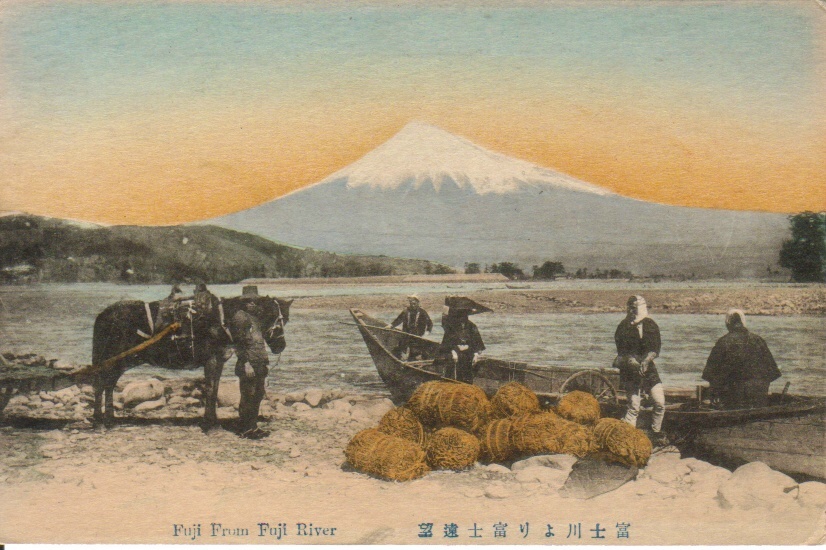 |
From the picture above, you might hear lullabies borne by breezes. The mother carrying the baby is walking slowly toward the other side while being watched by Mt. Fuji. The visual arrangement of the Mother and Mt. Fuji is uniquely superb and poetic. This wooden bridge was swept way again and again, and finally, in 1923, a long-awaited iron bridge was completed. |
17. Fujikawa Canal (Fuji City) 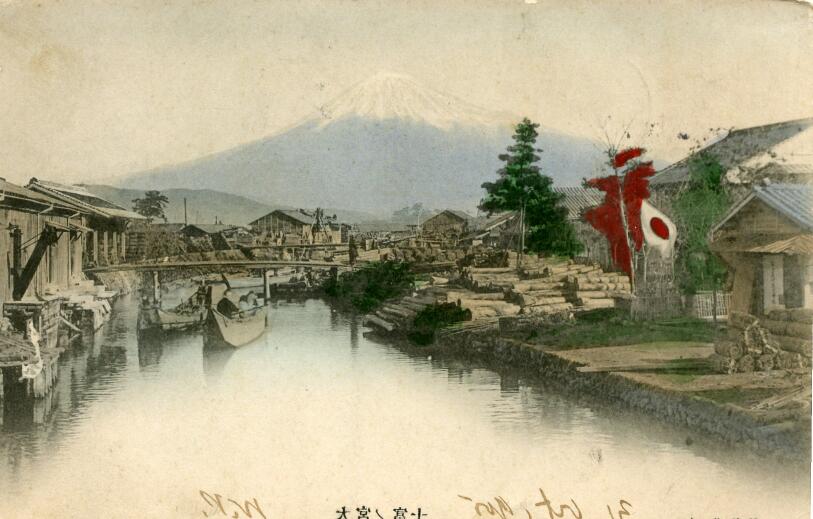 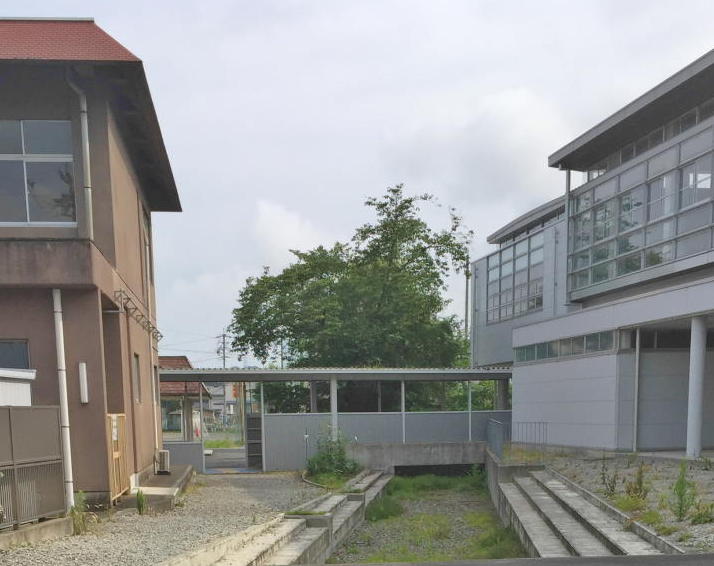 The trace of Fujikawa canal |
Fujikawa Canal was completed in 1872. Lots of straw rice bags and lumbers were brought here from Yamanashi prefecture, which is located upper stream. Those rice bags were once sent to Shimizu port through Horikawa canal and then sent to Tokyo by transferring via big ships. In about 1900, an American lady came here and drew paintings. Her name was Lilla Cabot Perry, an impressionist, and her grand-uncle was Oliver Hazard Perry, a hero of Battle of Lake Erie. She was a friend of Okakura Tenshin, a famous Japanese artist. Her third daughter married Joseph Clark Grew, who later became an Ambassador of US to Japan. By the way, when Tokaido line and Chuo line opened, this canal finished the mission being the station for the transportation of merchandise connecting Iwabuchi and Shimizu. |
| 18. In front of Iwabuchi Station (Fuji City) 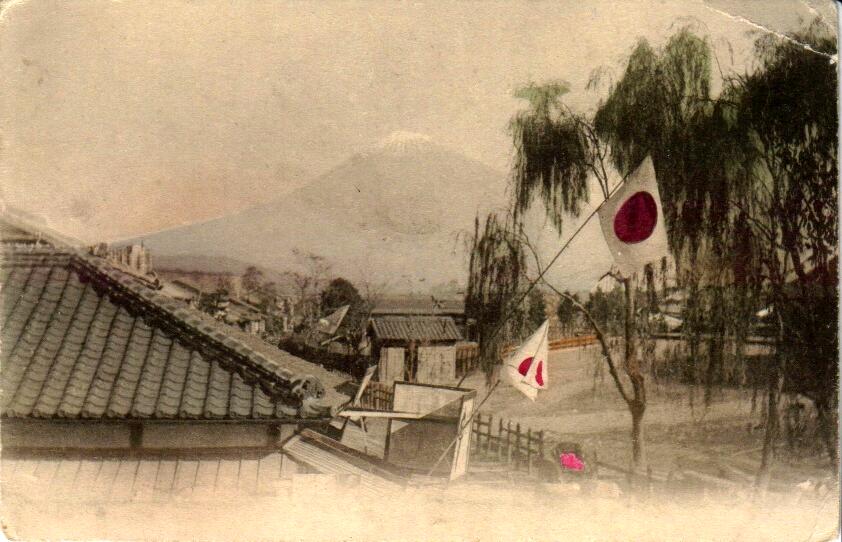 |
This picture was taken from the second floor of Taniya-ryokan hotel stood in front of Iwabuchi station, now Fujikawa station. In the early 20th century, there were approximately 100 hotels and inns around Iwabuchi station, and about 10000 people per month stayed there to visit and worship Minobu-san, which was called Mecca by followers of the Nichiren sect of Buddhism, or to climb Mt. Fuji. The open area on the right side became the Fujikawa station square park today. In the picture, you can see some willow trees which have been lost today, but the seniors still call this street " willow street". |
| 19. A Tea Garden (Fuji City)  |
More than 100 years ago, tea was one of the important exports from Japan. At that time Shimizu-no-Jirocho, a man who was famous for his chivalrous spirit, cultivated the tea field with many prisoners for the purpose of their rehabilitation. At that time, the locals also helped him, and they called the field Jirocho land. See the right piture of Jirocho land today. The azaleas are in full blossom over the tea garden, and beyond them where Mt. Fuji appears. This beautiful picture shows that the locals have the strong attachment to Jirocho land even now.  |
20. Clear Stream and Children (Fujinomiya City) 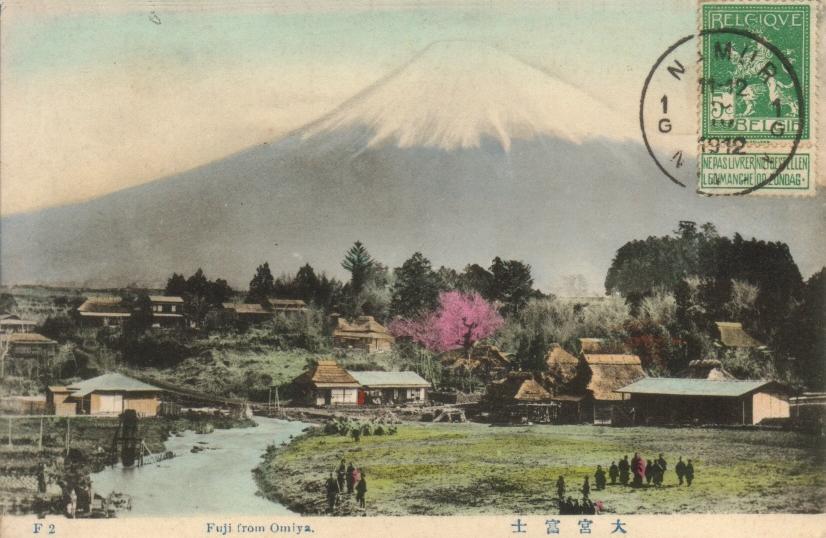 |
The rich and clear stream, clean air, the beautiful village and many children playing there are all “living” in the boundary of Mt.Fuji. The scene of the Kanda River is close to Fujinomiya Sengen Shrine. This post card was sent to France in 1912 and returned to Japan in 2010. And now it is in my house at the foot of Mt. Fuji. I feel as if this card has its own fate. |
21. A Farmer’s House in Fujinomiya (Fujinomiya City) 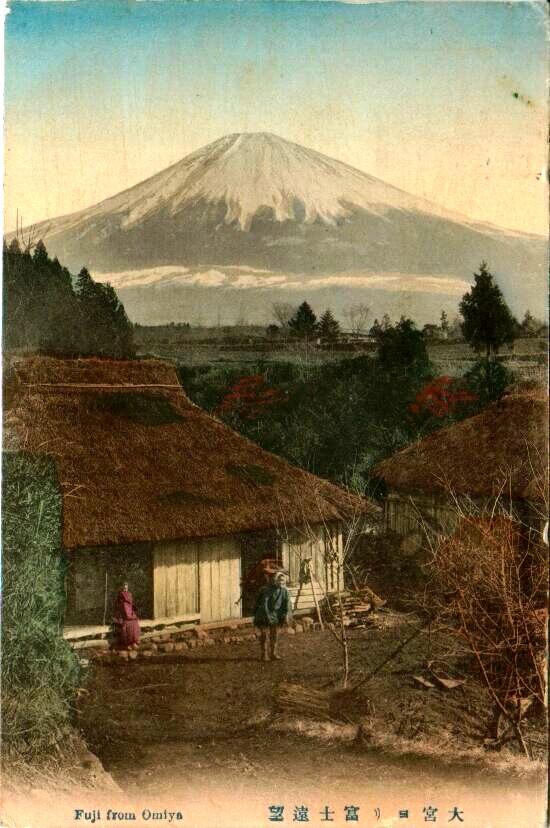 |
From the picture, in early spring, there is little stock of faggot under the eave. So the farmer is now going to collect firewoods. It is just like a Japanese-style painting. |
| 22. Saisho-kaku (Shizuoka City)  |
This building was built by a priest in 1910. The view from this area is rich and beautiful: Mt. Fuji is reflecting the sunset with shiny golden and silver waves through the pine trees. People once said that the building looked like a dragon palace floating on the sea. The building was demolished in the 1930s. However, Mt. Fuji and this beautiful area, Miho, were registered as one of the world heritages on June 22, 2013. |
| Acknowledgments: I received generous support from Craig on proofreading this book. I write down the will of thanks here. Copyright © 2018 Ichikawa Hiroyasu All Rights Reserved. |
|